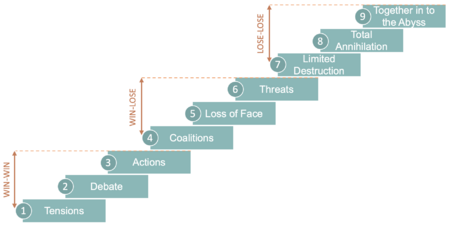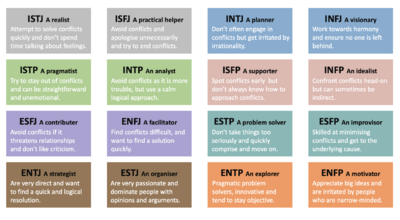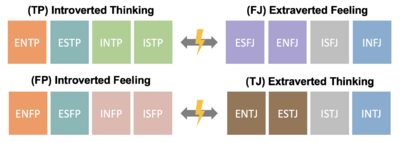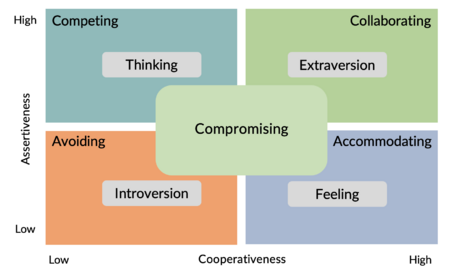MBTI in Conflict Management
Written by Anna Hessellund Diedrichsen
Contents |
Abstract
The article provides an examination of the application and advantages of Myers–Briggs Type Indicator(MBTI) in conflict management relevant to project management. Conflicts happen in all projects and by mastering the skills of conflict management, conflicts in team will lead to better outcomes and improve productivity. Conflict management relates to prevent conflicts from happening and resolve conflicts before escalation. Based on that the project manager(PM) must tailor behaviour, communication style and conflict management. MBTI is a tool that can be used to provide insights about a person's preferences concerning differences in how the person perceives information and makes decisions[1].
The fundamentals of MBTI is explained emphasising the four preferences, Extraversion vs. Introversion, Sensing vs. Intuition, Thinking vs Feeling and Judging vs. Perceiving, which combined assesses the way an person prefers to perceive information and make decisions. A person is assigned to one of 16 personality types. Further, the article argues for the application of MBTI in conflict management by emphasising the different MBTI types preferences linkage to the core activities in managing conflicts addressing how potential conflicts are identified, causes of conflicts and how to solve conflicts. Lastly, a critical reflection discusses limitations of MBTI.
Conflict Management
Conflict management relates to managing the team aiming at motivating the team and fostering a positive work environment according to DS/ISO 21502 [2]. The purpose of conflict management is to foster positive conflicts in a team. It is an essential soft skill to engage stakeholders and navigate in difficult situations to maximise performance and productivity [3][4]. From a pluralist viewpoint organisations consist of stakeholders having different values and goals where conflicts can be constructive[3]. Conflict management is the process of identifying, addressing, and resolving disagreements before they escalate. It is the art of managing arising conflicts and finding a mutually acceptable solution that satisfies both parties by identifying differences in values, preferences, and approaches present in a team [5]. Empathising different conflict management styles is of essence to manage conflicts constructively.

Causes of conflicts
Conflicts inevitable arise due to 10 causes in the process of developing team effectiveness, and are products of numerous variables leading to arguments between people competing personal interests. The most significant conflict causes are identified by prof. Y. AS from University of Johannesburg [7];
- Disagreements escalating
- Poor organisational structure
- Personality clashes / differences in values & goals
- Poor communication
In addition, the model of conflict escalation developed by Friedrich Glasl describes nine stages and three levels of conflict escalation. It is of interest to identify and solve a conflict in the earlier stages to ensure win-win result between parties, illustrated on figure 2[6]. Thereby, conflicts can be positive and lead to better outcomes hence it is relevant to understand individual preferences, needs and interactions across team members [3].
Myers–Briggs Type Indicator (MBTI)
The purpose of Myers-Briggs Type Indicator tool is to support project management to understand individuals in a team in order to manage them appropriately.
The Concept
The invention of Myers–Briggs Type Indicator assessment by Katharine Cook Briggs and Isabel Briggs Myers originates from the theory described by C. G. Jung about analytical psychology[8] . MBTI provides an examination of the individual’s conscious feelings and thoughts with the purpose of emphasizing differentiation in the way people perceive information and make decisions. Hence, MBTI discusses the individual’s preferences and not capabilities. It is the world’s most universally and widely used assessment tool to understand the individual's preferences and determine type. To clarify it is not a personality test but a test assessing a person's type [9].
The purpose of MBTI is to assess individual preferences which connect to preferred behaviour in teamwork, interactions and thereby understand how team dynamics arise and are likely to communicate and interact. The underlying assumption is that people have specific preferences which impact its behaviour pattern. MBTI empathises eight preferences which are paired into opposite preferences of two. An individual tends to favour one of two opposing preferences and will feel energetic, natural and competent when using a preferred preference however, by practice people can master the proficient of using the opposite preference. Awareness about MBTI enable teams to leverage different personalities and strengths to increase effectiveness.
The 16 MBTI Types
Overall, MBTI eight preferences can be combined and expresses a total of 16 different personality types, illustrated on figure 3. An individual's psychological type is represented by four preferences and reflects its behaviour and thinking in group work.

MBTI considers 4 categories collectively comprising the foundation of the individual’s personality type.
- Orientation: The category assesses where a person focuses its attention distinguishing between Introversion(I) and Extroversion(E). A tendency to prefer Extroversion focusses on the outer world emphasizing the power of engagement with people and activities. People who prefer Introversion focusses on the inner world of impressions and ideas.
- Perception: The category assesses the way a person perceives and interprets information considering Sensing(S) and Intuition(N). A person who prefers Sensing tends to focus on “here and now”, gathering information through senses. A person who prefers Intuition tends to gather information based on previous patterns and seeks the wider context and future possibilities.
- Judgement: The category assesses how a person makes rational decisions based on perceived information by distinguishing between Thinking(T) and Feeling(F). A person who prefers Thinking makes decisions based on logical arguments, defined rules and objective analysis. A tendency to prefer Feeling means a person makes decisions based on values and subjective consideration associating with the situation.
- Orientation: The category assesses the way a person deals with the outer world distinguishing between Judging(J) and Perceiving(P). A person who prefers Judging enjoy planning and an organised approach in contrast to a person who prefers Perceiving enjoy flexibility, keeps options open and like being spontaneous.

Identification of conflict pairs
The PM can identify potential arising conflicts between the 16 MBTI personality types by recognising conflict pairs. The last two letters of the MBTI type are defined as the conflict pair as the combination explains the way the individual make decisions and interact with the outer world, connected to focus and response to conflicts.
The Myers-Briggs Type Company identifies four conflict pairs; TJ, FJ, TP and FP, see figure 4. TJs have an extraverted thinking preference. They are rational and conflicts often arise when logic is challenged. In contrast, FP are introverted feeling types and prefer operating internally and conflicts arise when core values are challenged. TPs have an introverted thinking preferences and conflicts arise when trust is challenged. FJs are extraverted feeling types who are very focused on remaining relationships despite conflicts[1].
By being conscious about conflict pairs the PM can be proactive and early spot situations where conflicts may occur and what behavioural changes to be aware of as a symptom of dissatisfaction of team members. When conflict pairs collaborate in a team the PM must be aware of how team members are likely to interact and clarify to team members how to communicate and interact with other personality types. MBTI types with common preferences share qualities and are less likely to be in conflict however a homogenous group are more exposed to cognitive bias...
A relationship between MBTI and Thomas-Kilmann Conflict Mode Instrument for conflict resolution

Further, five conflict management styles are identified by K. W. Thomas and R. H. Kilmann relevant to consider in order to decide how to tackle arising conflicts. The Thomas-Kilmann Conflict Mode Instrument (TKI) developed by K. W. Thomas and R. H. Kilmann assesses the individual’s preferred conflict management style and identifies the five conflict management styles based on the two variables, Assertiveness and Cooperativeness, see figure 1 [3][7] [11].
- Accommodation / Smoothing (unassertive, cooperative)
- Avoiding / Withdrawal (unassertive, uncooperative)
- Competing / Forcing (assertive, uncooperative)
- Collaborating (assertive, cooperative)
- Compromise (intermediate assertive and uncooperative)
Research indicates correlation between preferred conflict management style and MBTI type, figure 4. Extroverted people are more likely to collaborate than introverted. A successful PM is aware of own conflict management style based on their MBTI type however can compensate to use alternative approaches for different conflict situations. By paying attention to different conflict management styles related to the MBTI type the process of tailoring behaviour and communication becomes effective in conflict resolution.
In relation to F. Glasl’s nine stages of conflict escalation high cooperativeness and assertiveness is preferred to create win-win situation reflecting healthy conflicts. When dealing with individuals who prefer introversion the PM must proactively encourage them to express their viewpoint and not leave a conflict instantly. Moreover, when setting a team the PM should consider including Extraverted Sensing types as they are proven to be natural conflict mitigators with the strengths of being realistic, and accepting facts and use them constructively stated by I.B. Myers [9]. They are likely to pull conflict factions together and make things run effortlessly.
Important, it is favourable to set a diverse project team across MBTI types and encourage stronger relationships between different MBTI types, appreciating different qualities in a conflict.
Application of MBTI in conflict management
Application of MBTI is useful in conflict management as the project manager will be able proactively tailor conflict management style and communication style when conflicts happen [2]. This section provides practical examples elaborating on how the PM can use the MBTI assessment in conflict management to manage the team before conflicts arise and during conflict resolution.
According to I.B. Myers [9], the individual’s personality MBTI type is consistent throughout its life however can change under an extreme period of its life or when a person goes through life changing situations. Based on the fact that a project is defined as a temporary endeavor, it is only necessary to take the MBTI once also in respect of resources and time. MBTI assessment consists of approx. 100 questions and can be used as the foundation to design a team and manage team members. It is valuable for the PM to determine own MBTI type to be aware of cognitive bias and preferred conflict resolution style. The purpose of using MBTI in conflict management is to mitigate the risk of a conflict entrance into second and third level of F. Glasl’s nine stages of conflict escalation[6].
Manage team dynamics to prevent conflicts
MBTI assessment is useful to understand the dynamics of the team to foster a healthy environment and a productive team. Once a team has been formed and all team members have taken the MBTI test, the PM should utilise the test results to gain an understanding of the various work styles and traits present within the team. By doing so, the PM can proactively identify potential conflicts before they arise and gain insight into the sources of such conflicts due to different MBTI types. In addition it can be of essence to share the results of the MBTI assessment with the team to foster acceptance of strengths, weaknesses, and differences across team members. This is useful to build trust, respect, and collaboration among team members and reduce the likelihood of conflicts arising.
An example: Lets assume that a team has a team member who is an ISTJ (Introverted, Sensing, Thinking, Judging) personality type and another team member who is an ENFP (Extroverted, Intuitive, Feeling, Perceiving) personality type. It is noticed that an ISTJ type tends to focus on the details of the project and wants to make sure everything is done correctly, while an ENFP type tends to think more broadly and creatively about the project, sometimes overlooking details in favour of thinking of the big-picture. The PM can use this knowledge to proactively address potential conflicts between the MBTI types by encouraging them to communicate openly and directly about their different work approaches. Thereby, potential personality crashes are mitigated.
When the PM approaches a TJ type, the PM may consider using a communication style that is focused on facts and logical analysis, as this will be effective for a TJ type. The same communication style is not effective for an FP type, as they may perceive it as unfeeling. Instead, the PM should use an empathetic and supportive communication style that takes emotions into account. This involves actively listening to the FP's concerns and acknowledging the person's perspective.
Manage arising conflicts and solve them
When a conflict has entered stages of the first level on the conflict escalation model due to one of conflict causes defined by Y. AS, the PM should work towards finding a solution that satisfy both parties involved in the conflict. The MBTI results may indicate team members behaviour when facing conflicts, valuable for the PM to choose a conflict resolution style and communication style that consider needs and preferences of each individual.
TKI identifies collaboration as a preferred mode of conflict resolution style to create a win-win solution hence the PM should empathise the key elements of collaboration such as ....MBTi indicate a person's conflict resolution style,--> be aware of own conflict resolution style. --> based on that a team member will be conscious about own behaviour in a conflict and proactively address weaknesses to use a more collaborating approach.
An Example: When interacting with an ENFP type it may be useful to choose a collaborating style of conflict management as it involves facilitating a collaborative discussion, since an ENFP tends to apply a collaborative approach based no figure 1. The PM can encourage the ENFP type to share creative ideas and insights, while also encouraging the person to listen to the ISTJ's perspective. In contrast, the PM should encourage the ISTJ type to appreciate other ideas and see the value in a more flexible and creative approach to problem-solving. An accommodating style of conflict management is appreciated based on TKI, figure 1.
ENFP and ISTJ
People with a preference for Introversion(I) and Feeling(F) tend to avoid conflicts more often than those with a preference for Extraversion(E) and Thinking(T). The PM must encourage those team members to engage in conflicts by using active listening more often and ask team members to summarise perspectives and to ask clarifying questions.
Choose conflict management style
Communicate effectively
Facilitate negotiation
Conflict Resolution Strategy
Facilitate and solve a conflict
In a conflict between two team members the conflict is mitigated by using the PM as the facilitator who will assist the parties in the conflict to clearly define the issue, understand interests and move to a resolution. A preferred communication style of an MBTI type is assessed in the test hence, by knowing the MBTI type of each party the PM can support both parties in how to convey a message effectively to the counterparty and what aspects to address of the counterparty to accommodate its way of perceiving information. Thereby, conflicts are mitigated and negative personality crashes are avoided.
In a team the PM must understand that communication between Thinking and Feeling types often crash due to Feeling types tend to feel attacked by Thinkers. Stakeholders with feeling preferences should advocate arguments to Thinkers by respecting cost of consequences, listing facts and keeping language objective. In contrast, Thinkers should focus on empathy acknowledging the opinion of the Feeling type and address the person’s concerns. A Feeling type will feel respected and heard and the conflict is likely to progress positively.
Additionally, according to I.B. Myers communication between Sensing and Intuitive types are constructive when Sensing people know the importance of paying attention to the initiatives and ideas from Intuitive people, while the Intuitive person must respect the importance of taking a step back and check the Sensing person follows its thoughts [9]. In successful collaboration, contribution from the Sensing type supports and strengthens the argument of the Intuitive type. In this situation, the PM must clarify to the Sensing type the best way to approach an Intuitive person and how the two personality types complement each other.
By understanding the MBTI type of the team members and the PM, the PM is able to constructively communicate to individuals and support collaboration across team members. MBTI enables the PM to quickly assess preferences and interests of team members to decide whether to address logic and facts or emotions and opinions interacting with Thinkers or Feelers in a conflict.
Limitations
This section reflects the application of MBTI and limitations relevant to the project manager.
Generalisation
- MBTI assessment categories people into 16 different fixed types allowing the PM to simply compare preferences and interests across a team. It is not as comprehensive and detailed as a personality test which provides an exhaustive picture of the individual and the complexity of its behaviour. Further, MBTI does not concern other relevant factors such as personal values, educational- and cultural background etc. The tool can easily be applied but is criticised to provide oversimplified results hence is not feasible in some situations.
Lack of Flexibility
- MBTI can be overemphasized as basis for understanding team members leading to misjudgements. A person with a tendency towards one preference can change behaviour in different conflict situations. It is important to use MBTI as a tool to understand the PM’s and team members preferences however be careful not to stereotyping individuals and view the individual as unique as all humans also appreciate preferences in different levels.
Negative Conflict Occurrence
- Application of MBTI can create conflict between the project team and PM if the team members feel labelled. The PM should not use MBTI for evaluation and judgement. MBTI in conflict management is a tool to support and understand team members hence, by conveying the message of the purpose and vision behind MBTI to the team members the PM can encourage buy-in.
Reliability
- A risk of dissonance is possible between a person’s self-perception and how other perceive it. As a result a person’s MBTI type may not reflect reality which can lead to negative conflicts and misinterpretation. In order to prevent dissonance MBTI can be supplemented by a survey evaluating how team members perceive each other. Thereby, mismatches and similarities will be examined and the PM is able to assess the correctness of the individual’s MBTI.
Conclusion
Conflict management is essential to effectiveness and successful collaboration in a team. Conflicts can be healthy if they are managed well by the project manager. Myers–Briggs Type Indicator test is a valuable tool for the project manager to determine own and team members' preferences by understanding how individuals perceive informations and judge the outer world to make decisions. Results from the MBTI test enables the project manager to master the skills of successful conflict management in the process of identifying occurrence of conflicts, understanding the cause of conflicts and solving conflicts. MBTI allows the project manager to simply categories team members into 16 types and assess similarities and differences across a team however by overemphasising MBTI results misjudgement and stereotyping are risks hence, MBTI is usable to understand and support team members not to evaluate.
Annotated bibliography (will be elaborated)
- Myers, I. B. & Myers, P.B. (1995). Gifts Differing. Consulting Psychologists Press, inc (CPP) [9].
- Project Management Institute, Inc.. (2021). Guide to the Project Management Body of Knowledge (PMBOK® Guide) (7th Edition). Project Management Institute, Inc. (PMI). [3].
- AS, Y. (2017). Conflict Management in Projects. IEEE Xplore[7].
- Human Capital at United States Geological Survey(USGS.gov). Thomas-Kilmann Conflict Mode Instrument (TKI)[11].
References
- ↑ 1.0 1.1 The Myers-Briggs Company (2023). Available online: https://eu.themyersbriggs.com/en/tools/MBTI
- ↑ 2.0 2.1 Dansk Standard. (2020). DS/ISO 21502:2020. Project, programme and portfolio management - Guidance on project management. Dansk Standard (DS) (1st Edition). Available online: https://findit.dtu.dk/en/catalog/60d31c4ad9001d00e85de43b
- ↑ 3.0 3.1 3.2 3.3 3.4 Project Management Institute, Inc.. (2021). Guide to the Project Management Body of Knowledge (PMBOK® Guide) (7th Edition). Project Management Institute, Inc. (PMI). Available online: https://app-knovel-com.proxy.findit.cvt.dk/kn/resources/kpSPMAGPMP/toc
- ↑ Popovic, K. & Hocenski, Z. (2009). Conflict Management. IEEE Xplore. Available online: https://ieeexplore-ieee-org.proxy.findit.cvt.dk/stamp/stamp.jsp?tp=&arnumber=5074859
- ↑ Fathi, K. (2010), Metatheory Building in Dialogical Conflict Solutions: Conceptual Advice Using the Conflict Transformation Approach of Galtung, Conflict Management by Glasl and the Integral Approach of Wilber. Integral Review. Available online: http://integral-review.org/pdf-template-issue.php?pdfName=vol_6_no_3_fathi_metatheory_building_in_dialogical_conflict_situations.pdf
- ↑ 6.0 6.1 6.2 Glasl, F. (2023). Friedrich Glasl's model of conflict escalation. wikipedia.org. Available online: https://en.wikipedia.org/wiki/Friedrich_Glasl%27s_model_of_conflict_escalation
- ↑ 7.0 7.1 7.2 AS, Y. (2017). Conflict Management in Projects. IEEE Xplore. Available online: https://ieeexplore-ieee-org.proxy.findit.cvt.dk/stamp/stamp.jsp?tp=&arnumber=8095588
- ↑ The Myers-Briggs Company. (2022). Introduction to Myers-Briggs® Type (7th Edition). Available as ebook: https://eu.themyersbriggs.com/ebooks/ebook-recipient-download?i=8GRxkRc76oNjeM0XR2N8Ymqf7vBV5oLEf%2fPAGwfg59g%3d
- ↑ 9.0 9.1 9.2 9.3 9.4 9.5 9.6 9.7 Myers, I. B. & Myers, P.B. (1995). Gifts Differing. Consulting Psychologists Press, inc (CPP), [Book].
- ↑ Kilmann Diagnostics LLC. (2023). The Relationship Between the TKI and the MBTI Assessment Tools. Kilmann Diagnostics LLC. Available online: https://kilmanndiagnostics.com/the-tki-and-the-mbti-2/
- ↑ 11.0 11.1 Human Capital at United States Geological Survey(USGS.gov). Thomas-Kilmann Conflict Mode Instrument (TKI). Available online: https://www.usgs.gov/human-capital/thomas-kilmann-conflict-mode-instrument-tki
Cite error: <ref> tag with name "SD_Daugaard" defined in <references> is not used in prior text.
Cite error: <ref> tag with name "AnneMarie" defined in <references> is not used in prior text.